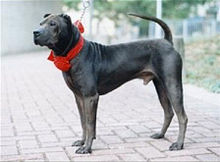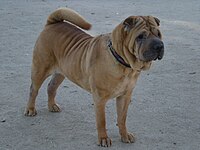Shar Pei
| Shar pei | |||||||||||||||||||||||||
|---|---|---|---|---|---|---|---|---|---|---|---|---|---|---|---|---|---|---|---|---|---|---|---|---|---|
 Modern "wrinkle-mouth" shar pei | |||||||||||||||||||||||||
 Traditional "bone-mouth" shar pei | |||||||||||||||||||||||||
| Other names |
| ||||||||||||||||||||||||
| Origin | China | ||||||||||||||||||||||||
| |||||||||||||||||||||||||
| |||||||||||||||||||||||||
| Dog ( domestic dog ) | |||||||||||||||||||||||||
The shar pei (Chinese: 沙皮; Cantonese Yale: shā pèih; pinyin: shā pí) is a dog breed from
History
There are no records indicating the origins of the shar pei, although it closely resembles effigies of an un-wrinkled type of
The shar pei was once very popular, but war and political turmoil in China in the 20th century took its toll on the breed and by the 1970s it was close to extinction.
The cause of saving the breed was taken up in the United States by enthusiastic breeders using the dogs smuggled there in the 1970s, a breed club was founded and it received American Kennel Club recognition in 1992, with breed standard specifying a meat-mouth type dog.[2][3] Some breeders in Hong Kong maintain the traditional bone-mouth type, although it is estimated only 50 to 100 examples of this type remain.[3]
In the United States, a number of breeders have selectively bred shar peis for a smaller size, creating what they call the "miniature shar pei", much to the opposition of many breeders of traditionally sized shar peis.[2] Standing to a maximum 40 centimetres (16 in), the miniature shar pei is bred for both for its smaller size and increased wrinkles.[2]
Description

The shar pei is a short-coated medium-sized breed of dog, renowned for its excessively wrinkled skin. The breed resembles many dog breeds from the
Adult shar peis typically stand between 44 and 51 centimetres (17 and 20 in) and weigh between 16 and 20 kilograms (35 and 44 lb), they have a short, very harsh coat that can be any solid colour except white, although black, red, fawn and cream are the most common.[5][8]
The Chinese breed standard states they have clam-shell ears, butterfly nose, melon-shaped head, grandmotherly face, water buffalo neck, horse's buttocks and dragon's legs.[5] The breed's head is relatively large compared to its body with a broad muzzle that usually darker than the rest of the coat and well padded causing a bulge at its base, the ears are set wide apart and are small and triangular, and the eyes are set very deeply into the folds of skin on the head.[5][8] The breed has straight, well boned, muscular legs below sloping shoulders and a medium length broad tail that is curled over their back in a manner typical of spitz-type dogs.[5][8]
Health
Life expectancy
A 2024 study in the UK found a life expectancy of 10.6 years for the breed compared to an average of 12.7 for purebreeds and 12 for crossbreeds.[9]
Skin conditions
A review of over 23,000 records from the University Veterinary Teaching Hospital of the University of Sydney found 7.7% of Shar-peis to have atopic dermatitis, higher than the overall of 3.1%.[10] A review of records from over 600 US hospitals found 4% of Shar-peis under the age of 2 to suffer from juvenile onset demodicosis compared to just 0.58% overall.[11] A study in the UK found the Shar-pei to have an overall prevalence of 0.9% compared to 0.17% for the general population. For juvenile onset demodicosis (under 2 years) the Shar-pei had a prevalence of 1.8% compared to 0.48%. For adult onset demodicosis (over 4 years) the Shar-pei had a prevalence of 0.6% compared to 0.05%.[12] The Shar-pei is predisposed to several skin conditions including:
Familial Shar Pei Fever

Shar Pei fever (also called familial Shar Pei fever or FSF) is a condition seen in Shar Pei characterized by recurring
Affected Shar Pei have an elevated level of
The symptoms of Shar Pei fever include fever, swelling, and pain in the hocks that usually resolves within two days. The swelling in the hocks is easily recognizable—the hock will resemble a flaccid waterballoon, rather than stiff swelling following a sprain or break. The symptoms can be treated with
Other conditions
The Shar-pei is prediposed to hypothyroidism.[13]
A common problem is a painful eye condition, entropion, in which the eyelashes curl inward, irritating the eye. If untreated, it can cause blindness. This condition can be fixed by surgery—"tacking" up the eyelids so they will not roll onto the eyeball for puppies, or surgically removing extra skin in adolescent and older shar peis.[17]
Vitamin B12 deficiency is a common problem in the Shar Pei and is suspected to be hereditary.[18][19]
A review of over 250,000 elbow scans in North America found a 24% of Shar-Peis over the age of 2 to suffer from elbow dysplasia.[20]
A review of hospital records in North America found 4.4% of Shar-Peis to suffer from glaucoma compared to 0.71% for mixed-breeds.[21]
See also
References
- ^ Indianapolis Museum of Art - Seated Shar Pei Dog
- ^ ISBN 1-57076-219-8.
- ^ a b c d e f g "Discovering the Shar Pei: an endangered dog breed". Hong Kong Tatler. Hong Kong: Tatler Asia Limited. 23 Jul 2012. Retrieved 21 July 2020.
- PMID 22615366.
- ^ ISBN 978-0-7566-6004-8.
- ^ Wilcox, Bonnie; Walkowicz, Chris (1995). Atlas of dog breeds of the world. Neptune City, N.J.: TFH Publications. p. 22.
- PMID 28445722. Figure 1
- ^ ISBN 978-1-78197-890-0.
- PMC 10834484.
- PMID 27188769.
- ISSN 0959-4493.
- PMID 31584708.
- ^ ISBN 978-0-323-37651-8.
- ^ ISBN 0-7216-6795-3.
- PMID 11272460.
- PMID 21437276.
- )
- PMID 19926684.
- PMID 21652239.
- ISSN 1932-6203.
- ISSN 1463-5216.
External links
- Shar Pei at Curlie


